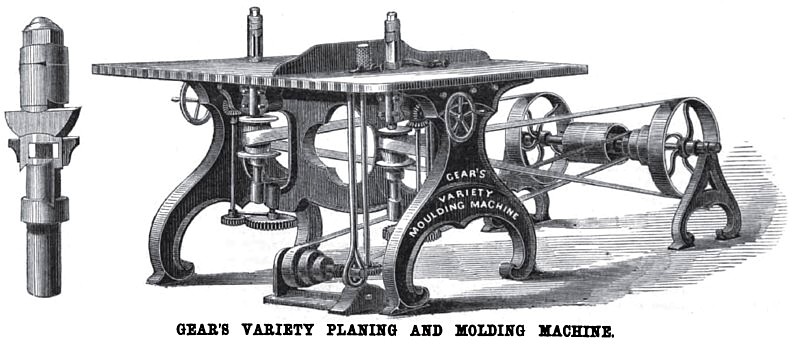|
Title: |
1868 Article-A. S. & J. Gear & Co., Variety Planing & Molding Machine |
|
Source: |
Scientific American 02 Dec 1868 pg 357 |
|
Insert Date: |
5/4/2012 9:18:36 PM |
Improvement in Wood-working Machinery
Among the many noticeable articles exhibited at the Crystal Palace in this city was a curious and ingenious contrivance for cutting irregular forms in wood—the need of which had been long and seriously felt, and which has since completely revolutionized the manufacture of furniture—the invention of Mr. Nathaniel Gear. A broad table, say four feet square, rested upon an iron frame, at the usual height of a carpenter's bench, and rising from the surface near one end were the heads of two vertical spindles, or shafts, which projected but a few inches and constituted the most important part of the machinery ; in fact, the very principle of the invention.
The peculiar construction of the heads, into which were placed sharp knives similar to common planing irons grooved and formed to suit the various styles of work desired, could not be more simple or efficient. The whole strength of the cutters being available and not impaired by holes or strained by wedges as is generally the case in holding all other cutters. The material to be planed was held upon a pat tern of the form desired, by a few metallic points, and the pattern being carried past and against the heads while rotating, the material upon it was planed and molded to the shape of the pattern and knives used. Two heads were used in order to work the grain of the wood and
thus impart a beauty of finish that could not be otherwise obtained.
The engraving accompanying represents this same machine in its improved state, the result of some fifteen years experience in building and perfecting it, and while it has been essentially improved in build, it is worthy of note that the principle of the machine, the manner of holding the cutters and using the heads as a gage or guide to the pattern conveying the material to be dressed, has never been changed. By the graduation of the knives, the machine may be adapted to work of any size, making the heads even from one-half of an inch, to four inches in diameter; so that the machine may be used in doing the most delicate irregular woodwork.
It is now used in planing the wood handles to hairbrushes, and also in dressing plow beams and the knees of ships.
The engraving represents upon the table top of the machine, a guide, connected with which is a feed roll, which receives power to move it from the pulleys beneath the table, and when attached completes the machine for doing straight as well as irregular work.
By the hand wheel arrangement represented at each side of the machine, the spindles are raised or lowered as occasion requires, adapting the cutters to the thickness of the material operated upon.
The cutter head at the left of the machine (on Fig. 2) represents the head with several cutters; the additional and extra cutters being held in a simple manner by an adjustable intermediate collar, the invention of Mr. L P. Tice.
The machine weighs about thirteen hundred pounds, and is valuable for furniture, carriage, sash, door, and blind makers, and any establishment working wood by machinery. Patented Nov. 8, 1853, and extended Sept, 30,1867.
For information concerning D. Jordan's Patent Guards by which the shavings are gaged the same as in common planes (a valuable improvement to the machine), and all further particulars concerning the same, address the owners and manufacturers, A. S. & J. Gear & Company, New Haven, Conn., and Concord, N H.
Patent #s 10,204 & 64,227 |
|
 1868 A. S. & J. Gear & Co., Variety Planing & Molding Machine
1868 A. S. & J. Gear & Co., Variety Planing & Molding Machine
|
|